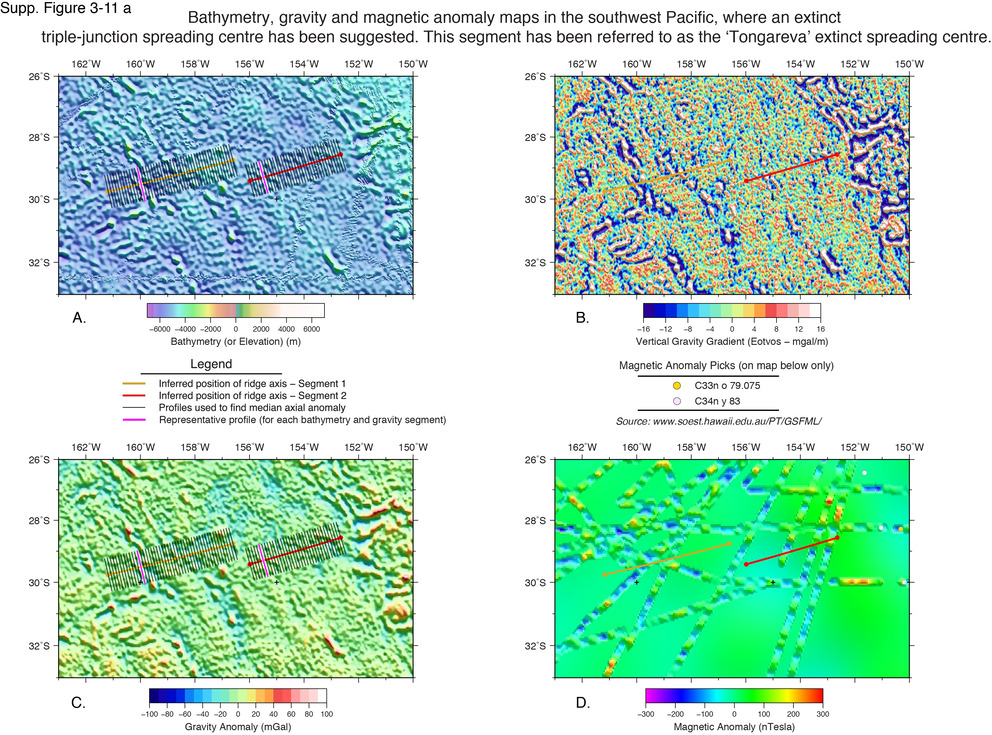| Ocean: | Pacific |
| Spreading center type: | Large-scale extinct MOR |
| Time of cessation: | Cretaceous Quiet Zone (CTQZ) |
| Cessation style: | Uncertain |
| Later deformation or volcanism: | Uncertain |
The Tongareva extinct spreading centre is argued to be an eastern extension of the spreading system that formed the Osbourne Trough (Seton et al., 2012), which is thought to have formed the plate boundary between the Pacific and Phoenix plates during the middle Cretaceous as discussed in Supplementary Data Section 3.06. The segments of the proposed Tongareva ridge trend roughly east-west and are thought to be located to the east of the East Wishbone Ridge and with spreading oriented in a north-south direction.
Taylor (2006) proposed that the southern plate boundary of the Pacific Plate during the CTQZ must have met at least two other plates that he refers to as the 'Hikarangi' and Phoenix plates. Taylor cites fracture zone trends and abyssal hills as the main evidence for this, with the key features illustrated in his Figure 1 where different angles of inclination of fracture zones are evident either side of the Wishbone Scarp where it intersects the Louiseville Ridge (Taylor 2006, p. 373).
The Osbourn Trough and Tongareva spreading centre segments may have formed one limb of the triple junction between the Pacific-Hikarungi and Phoenix plates. Larson et al. (2002) indicate what they describe as the extinct-spreading centre ‘trace’ in their Figure 1 (p. 67).
If the Tongareva and Osbourn segments were formed simultaneously, it is difficult to explain the difference in the patterns of magnetic anomalies either side of the Louiseville Ridge around 157° W, given that magnetic isochron identifications suggest very different spacing (and subsequently spreading rates) (see the magnetic anomaly identifications illustrated in Larter et al., 2002, their Figure 2a, p. 5 - 3). Recent gravity gradient grids (Sandwell et al., 2014) also show very complex tectonic fabrics east of 165 W, suggesting the possible presence of microplates and related small-scale plate boundary reorganizations.
There is no obvious 'ridge-like' structure that can be identified within the region and we do not include the proposed Tongareva extinct spreading ridge in our statistical analysis.
Larson, R.L., Pockalny, R.A., Viso, R.F., Erba, E., Abrams, L.J., Luyendyk, B.P., Stock, J.M. and Clayton, R.W., 2002, Mid-Cretaceous tectonic evolution of the Tongareva triple junction in the southwestern Pacific Basin, Geology, v. 30, no. 1, p. 67-70.
Larter, R.D., Cunningham, A. P., Barker, P. F., Gohl, K. and Nitsche, F. O., 2002, Tectonic evolution of the Pacific margin of Antarctica: 1. Late Cretaceous tectonic reconstructions. Journal of Geophysical Research, v. 107, no. B12, p. 5-1 - 5–19, doi: 10.1029/2000JB00005.
Sandwell, D., Müller, R. D., Smith, W. H. F., Garcia, E. S., Francis, R., 2014, New global marine gravity model from CryoSat-2 and Jason-1 reveals buried tectonic structure, Science, v. 346, no. 6205, p. 65-67.
Taylor, B., 2006, The single largest oceanic plateau: Ontong Java–Manihiki–Hikurangi, Earth and Planetary Science Letters, v. 241, p. 372–380.


